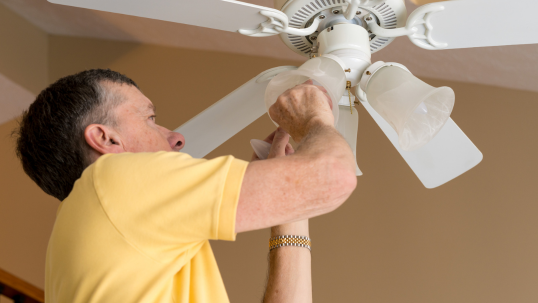Why Ceiling Fans Are Always In Style
Interior designers might not make a ceiling fan the focal point of a space, but aesthetically minded and function-first crowds both love what these handy devices offer. Ceiling fans help lower heating and cooling costs and improve comfort in your home in the Montgomery, Prattville, Wetumpka, or Millbrook area. On their own or as a complement to your home’s heating and cooling systems, ceiling fans are a surprisingly cost-effective solution to maximizing energy efficiency year-round.
How Do Ceiling Fans Work?
Ceiling fans work by circulating air throughout a room, creating a gentle breeze and moving warm or cool air where it’s needed most. Although ceiling fans do not actively cool air like air conditioning units, they do increase the rate at which air circulates.
Other variables in ceiling fan performance include the shape and angle of its blades and the direction it spins. In terms of the spin direction, you can change this and use your fan all year!
- Ceiling fans should spin clockwise in winter. Because warm air rises, a clockwise spinning fan will create an updraft, pushing warmer air down along the walls. After you set your ceiling fan direction for winter, set the speed to a low setting to avoid creating a breeze.
- The ceiling fan direction for summer is counterclockwise. This creates a downdraft that produces a cooling breeze throughout the room. The faster the fan spins, the more air it moves, and the more of a breeze you’ll feel.

Are Ceiling Fans Outdated?
Despite being invented in 1882, ceiling fans remain one of the most effective (and simplest) cooling methods available to homeowners worldwide.
Ceiling Fans Are Efficient
Are you wondering, “Are ceiling fans energy efficient?” Although efficiency varies by model, most ENERGY STAR-rated ceiling fans are more energy efficient than central air conditioning units. They’re also more efficient than portable fans because they move substantially more air by volume.
Read more: Energy Efficiency Tips To Save Money
Are Ceiling Fans Worth It?
Absolutely! A ceiling fan allows you to raise your thermostat by 4 or 5 degrees during the summer, contributing to measurable ceiling fan energy savings each year. If you run them in the other direction during the winter, they distribute heat more evenly to reduce how often and how long your heating system runs.
Modern Ceiling Fan Tech Is Smart
Ceiling fan technology didn’t stop in 1882. Modern ceiling fans have improved motor and blade designs to reduce energy use and move air more efficiently, and many pair with smart home systems like Alexa or Nest. This allows your HVAC and ceiling fan to complement each other and maximize your energy savings and comfort.
How To Choose the Right Size Ceiling Fan
If you want to install a new ceiling fan, be sure to choose the right size. Ceiling fan sizes are based on the blade span, which is the full diameter of the circle made by the blades when they spin. If a fan is too small, it will not provide enough airflow, and a fan that is too large can create an overwhelming breeze and dominate the room.
ENERGY STAR recommends finding the right ceiling fan based on the square footage of the room where it will be installed:
- For rooms up to 100 square feet: 29- to 36-inch fan
- For rooms up to 400 square feet: 36- to 50-inch fan
- For rooms larger than 400 square feet: 50- to 71-inch fan
Our Ceiling Fan Expertise Makes Installation a Breeze
At AirNow Home Services, we understand the major impact that energy efficiency can have on a household's financial expenditures. Our comprehensive home services are engineered to optimize system performance while ensuring reliable, hassle-free operation. Whether it's HVAC system maintenance or the installation of ceiling fans, you can trust our skilled, experienced technicians to deliver high-quality workmanship.
Call 334-384-6050 or contact us online to schedule HVAC, electrical, or plumbing services in Montgomery, Millbrook, Prattville, and the surrounding areas of Alabama.
